****UPDATE 20 May – I’ve been rewriting lots of the info on here – as a result this blog is, at best, interesting discussion fodder – I’ll post the new version in a few days***
Welcome back (if you’ve been here before) and welcome (if you’re new). This isn’t one of my epic 5,000 word blog posts this week but may (of course) feature lots of passing references to fruit and also a much maligned Frenchman called Pierre (bet you wish you’d read more of my blogs), as well as some thoughts about this week’s Corona Virus Shitstorm Problem That Needs Solving Of The Month™.
This is part of a bigger thing I’ve been working on so is partially formed* so you may** disagree with elements*** of what is written here.
I’ve tried to be a practical as possible – if you need broader strategic vision on what this means to the sector, or how we’re all going to change as people you’re in the wrong place. Not that I don’t have those opinions (and I have some quite strong opinions about how theatres are run and art is made), it’s just that, let’s be frank, that sort of stuff is much better coming from someone who swears less and gets to the point more effectively.
If you enjoy this or it’s useful**** then please tweet me, Linkedin message me or comment at the bottom of the post (it’s dead easy!) – it’s great for my ego – but for heaven’s sake don’t use the Contact page on my website (it’s broken and I haven’t mended it yet – which is, I’ve reasoned with myself, the cause of the wall of silence I get after every post).
*For a change – my ideas are usually flimsy at best
**Probably – honestly loads of people disagree – some purely because they’re my marketing nemesis because I MAY have been rude about their ideas ONCE at an AMA Conference in 2010. Get Over It.
***All
****There’s a good chance reading this may be a massive waste of time

A Quick Intro
Social spacing is going to happen. Let’s get that out now. I feel pretty confident, 99% sure that it will (and if it doesn’t then that’s a good news story and someone’s found a cure for something).
Not everyone will need to socially space their venue, for some the economics just won’t work and preserving cash reserves as long as possible to give yourself a fighting chance of surviving when social spacing makes a lot of sense (to me at least). Considering it though should be vital – this might last 2 weeks more (it won’t), it might be a year or more. Assuming that many venues sell around 60% – 70% of capacity normally, in a dry spell (of the type we’re about to enter), 40% – 50% may be “the new normal” in the short term (shoot me if I ever use that phrase again) – whether that’s viable or not is a different question.
I’ve been having a look at (with colleagues) some of the things we’ll need to do to a) make use of the Indigo Survey data, b) make audiences feel more comfortable about coming back and c) reopen our doors so that we’re proactive, front-footed and not caught out.
Things on the list that we’re considering (this is a small chunk of it):
- Reduced Capacities
- Queue Reduction measures
- Social Spacing in theatre spaces
- Availability of hand sanitiser in buildings
- Enhanced Cleaning
- On-site temperature monitoring
- Venue sign in for all party members
- Compulsory face masks
- One-way systems around buildings
- Timed seating of spaces
- Staff PPE
- Cashless Buildings
- Making secondary spend possible
- More flexible refunding and exchanging systems
- Thinking about pricing and concessions
- Messaging and how we talk to audiences
- How we do work in the community
- How we can use our spaces differently
- How we can programme, create and share work differently
- What it means for our teams
Someone returning to the theatre after our enforced closure will have a very different experience than before.
When Pierre, a merchant banker from Lyon, and his wife (formerly married to the novelist who met her in the Loire Valley in France when he went to open his own wine merchants – which has subsequently closed due to his heartbreak) buy a ticket when they visit the area on what they describe as a Grand Tour of Northern “powerhouse” England in October (when the leaves are turning to their autumnal shades) their experience will, inevitably feel more micromanaged, with more communication touch points and more regularly wiped down surfaces than had ever been wiped down in theatre before. But auditorium social spacing, where they sit in the theatre, I suspect, will be the biggest change Pierre and Marie-Claire will discover.
The question is which version will it be*… Here’s a few of my thoughts to ponder**. Oh and a poll at the bottom. If you’re interested in the full document I’m writing then pop a comment at the bottom saying “I’d like a read” and I’ll fire it over when done. So, how many segments of clementine (seats) can we fit in our skin of clementine…Here goes…
*Oh, btw this assessment isn’t what is scientifically or medically recommended (although there is not a full consensus from those either), but from an organisation’s operational point of view – to try and help us work out what to do if what comes back is really vague.
**Thoughts that could be out of date this time tomorrow of course.
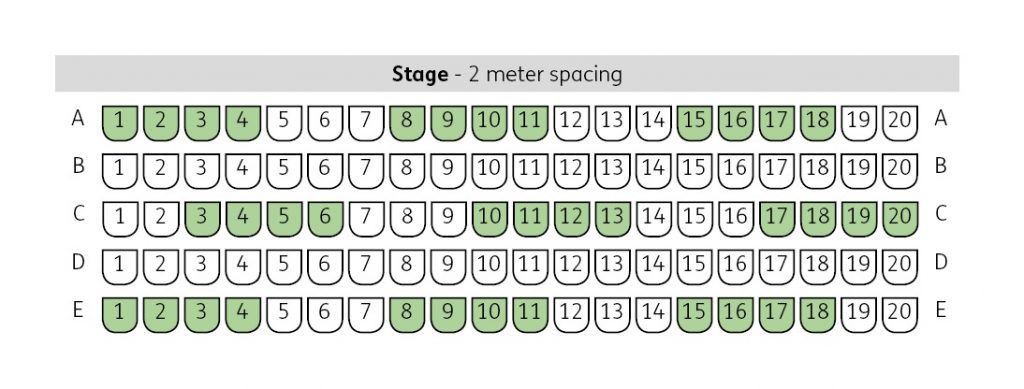
2m social spacing
☑ Pros
• 2m spacing offers defined spacing that people are used to
• Follows Governments 2m spacing narrative
• Reduced capacity reassures audiences
• Maintains the ‘by household’ approach to distancing
☒ Cons
• Capacity approx 21% – 35%*
• Row access isn’t great, climbing over people etc..
• Difficult to manage booking on and offline at the moment
• Entrances and exits can become covered by spaced areas
• If the rows of your theatre are tight then 1 row removed may not be enough. I measured and ours are just.
*Obviously depends on group size, auditorium size and layout – my figures are based on a generic 500 seat proscenium venue which I then worked out the impact by group size.
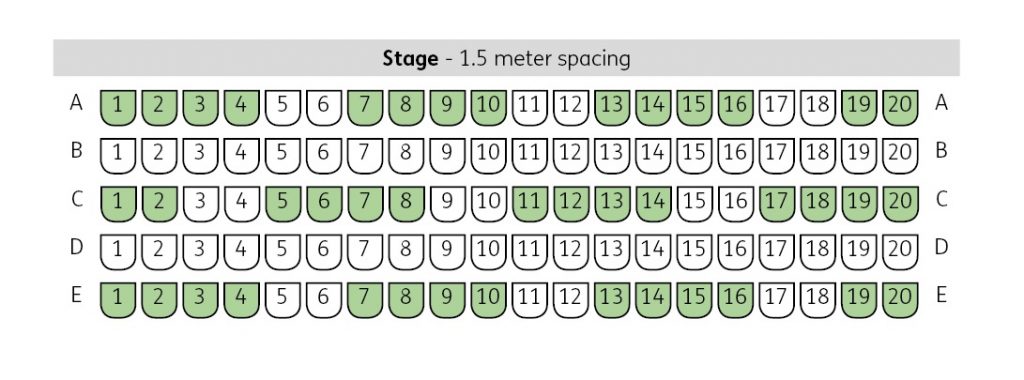
1.5m social spacing
☑ Pros
• 1.5m spacing offers defined spacing
• Reduced capacity reassures audiences
• Still feels really distanced
☒ Cons
• Capacity approx 26% – 39%
• Row access isn’t great
• Difficult to manage booking on and offline (slightly easier than 2m)
• Entrances and exits can become covered by spaced areas
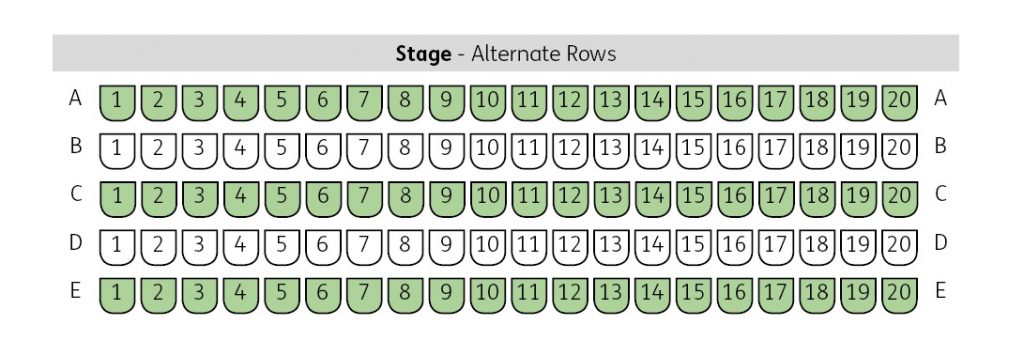
Alternate Rows
☑ Pros
• Reduced capacity reassures audiences
• Simple to manage online an at box office
☒ Cons
• Capacity approx 52%
• Row access is bad
• No lateral spacing between household groups.
• Doesn’t heed Government’s social spacing narrative
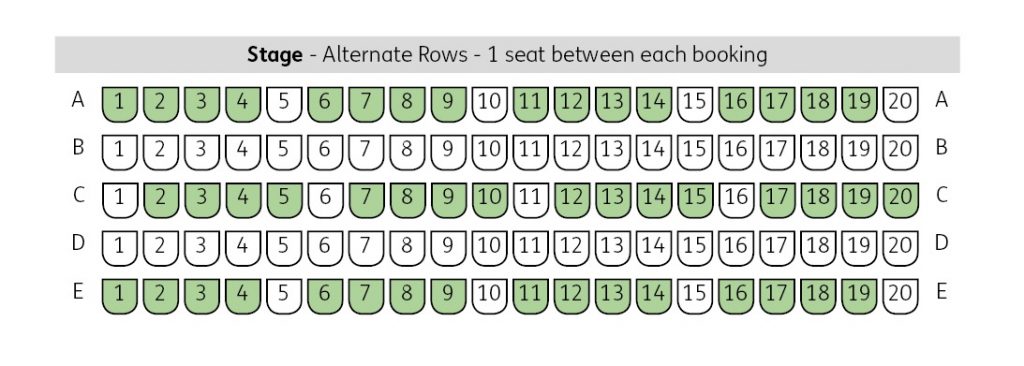
Alternate rows with 1 seat between bookings
☑ Pros
• Reduced capacity reassures audiences
• Some lateral spacing between groups
• Heeds social spacing narrative (but not the precision of 2m*)
☒ Cons
• Capacity approx 35% – 45%
• Row access isn’t great
• Social spacing distance is lower than UK Government’s 2m
• Difficult to manage booking on and offline
*Current recommendations around the world range from 2m, 1.5m, 6ft and 1m – The final figure is the one that’s on the WHO website – I’ve not really used the 1m figure as all the UK narrative has been driven around 2m.

Front & back spacing
☑ Pros
• Reduced capacity reassures audiences
• Some lateral and vertical spacing between groups
• Heeds social spacing narrative
• lower per-row capacity
☒ Cons
• Capacity approx 50%
• Entry in and out of rows isn’t ideal
• Social spacing distance is lower than UK Government’s 2m
• Nightmare to manage booking particularly with curved rows
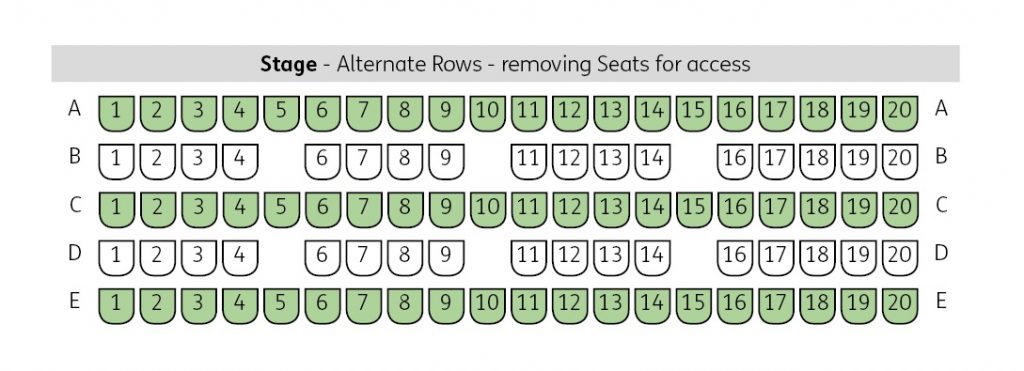
Alternate rows removing seats for access
☑ Pros
• Reduced capacity reassures audiences
• Simple to manage online an at box office
☒ Cons
• Capacity approx 52%
• Row access is improved
• No lateral spacing between household groups.
• Doesn’t heed Government’s social spacing narrative
• Requires temporary structural auditorium change

50% (or XX%) capacity reduction
☑ Pros
• Reduced capacity is reassuring for audiences
☒ Cons
• Capacity 50%
• Entry in and out of rows is bad
• Row access isn’t great
• No lateral or vertical spacing between household groups.
• Doesn’t heed Government’s social spacing narrative
• Likely to feel unnerving if there’s no spreading out of people
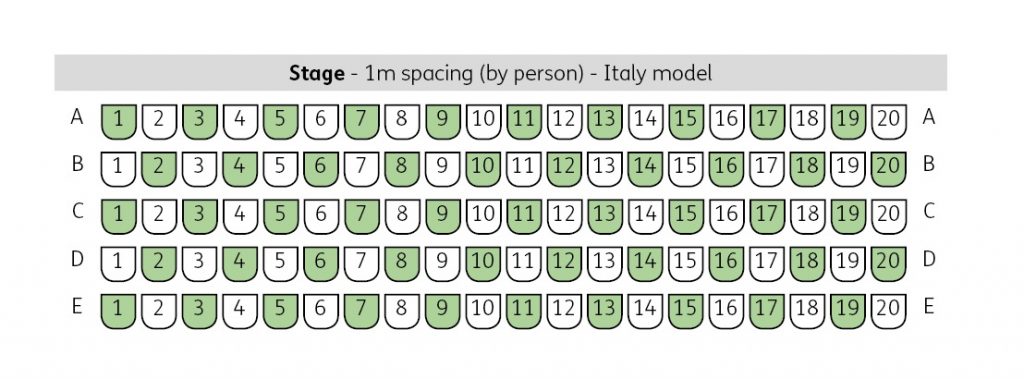
1 meter spacing (by person) – Italy Model*
☑ Pros
• Reduced capacity is reassuring for audiences
• Limited social spacing
• Follows social spacing narrative
☒ Cons
• Capacity 50%
• Entry in and out of rows isn’t ideal
• Row access isn’t great
• Loses household group narrative (so we can lie next to someone in bed but not sit next to them in the theatre?)
*This is an estimation of what the Italy model implies based on what I know.
And finally…
So which would I go with?
Alternate Rows Removing Seats For Access but with a caveat by saying that for performances from July to Oct we should also add single seat spacing between groups as well.
Why?
Practically it’s the one that’s most easily achievable across a massive range of venues – it doesn’t hurt the most (but still hurts), maintains the narrative of households spacing and when in combination with everything else on the massive list above seems like the smartest, easiest, most implementable solution.
A few people have mentioned making all spaces unreserved. I’m a little (a lot) against this – firstly unreserved venues tend to have massive queuing issues (it was the reason we ended it at Unity and at Clwyd) – people like to know where they’re sitting (arty people though like the scrum) – demand management is easier in a reserved venue – people book much later for unreserved venues in my experience – also, if you think every seat being the same price is accessibility then you need to think about it some more.
That’s it (for today) tell me what you think (or just have a think and a ponder). Night xx

11 responses to “Social Spacing (In Theatre)”
“I’d like a read” of your finished things – thanks!
Love your posts Sam!
I’ve sat in the auditorium a lot over the last two months, trying to imagine how it will look. This is a great article, I’d love to read more.
Thanks
Jemma
Interesting article – thank you. The removed seats are a great way to allow access and would work well, just feel you need space between groups on a row. I work for a theatre for young people and family bookings are usually 2 or 4. Perhaps alternate the bookable rows to clumps of 2 or 4 ?
“I’d like a read” of your finished things – thanks!
Stephen
If you can get your box office system to put the gap in between for you then you mightn’t need to have defined static areas?
I’ll fire it over when done!
I’d like a read
Thanks for this Sam, so interesting and it made us smile too. Would love a read of the full version when it is done
Ha ha, cheers!
Hi Sam
I’m loving your posts??
Thanks
Guy
Lovin yr work.
With your permission I will pass this onto the Society of Independent Theatres.
At some point, The Cockpit will be opening socially distanced, doing whatever it takes etc etc.
One thing it will take is fitting engaged/vacant locks to outside toilet doors (rather than just cubicles inside) so that they can be used one person at a time. Just thought I’d mention it in case it hasnt been covered.
Good toilet suggestion!
I’ll send you a more finished version next week if I may?
Cheers Guy!